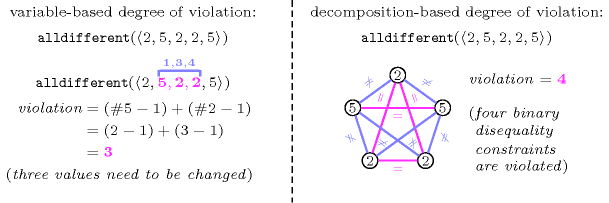2.1.5. Cost violation view
Considering a constraint for which all variables are fixed such that the constraint does not hold, a question is to evaluate the degree of violation of that constraint assuming that for a satisfied constraint the degree of violation is equal to zero.
For the constraint we can define its degree of violation by the minimum number of variables to reassign in order to get a solution. This is called the variable-based degree of violation. We can also define its degree of violation by the number of pairs of variables that do not satisfy the disequality constraint. This is called the decomposition-based degree of violation. Figure 2.1.4 illustrates these two degree of violation costs.
Figure 2.1.4. Illustration of the variable-based and the decomposition-based degrees of violation for , where denotes the number of occurrences of value in the argument of the constraint instance
